
Broughty Castle
The external features of the castle

Broughty Castle, with the harbour in the foreground
Broughty Castle is set on a rocky promontory at the mouth of the River Tay. The site appears to have first been fortified in 1454, when the fourth Earl of Angus received permission to build a small fort or fortalice here. However, it was the second Lord Gray who organised the building of the tower house, which was finished by 1496. Gray's tower house was a rectangular structure with four main storeys. There was also a garret within the roof, set back from a wall-head parapet or walkway. The tower house was originally entered at ground level, where there were vaulted basements, and a stair led up to the main hall on the first floor. The upper floors of the tower were used as bedchambers. The drawing below shows how the castle may have looked when it was built in the late 15th century.
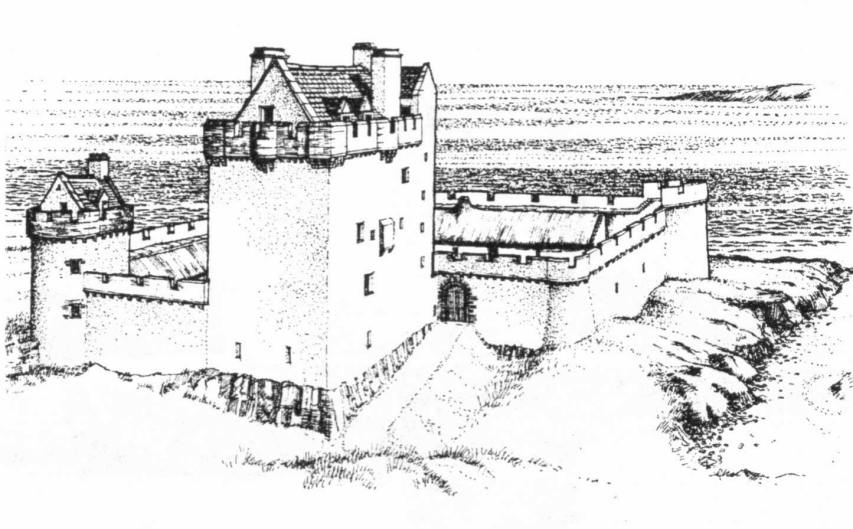
Reconstruction drawing of the medieval castle (by David Walker)
In the drawing above, you can see how the castle was originally almost surrounded on three sides by water. It has a commanding view across the River Tay and out to sea. The tower is built directly on top of the rock, and there was a courtyard, containing smaller buildings such as stores and stables, protected by high walls.
Standing at the bottom of the stone walkway up to the castle's entrance, today, you have a good view of the tower, the oldest part of the castle. It has changed a little since the 15th century, but many parts of the original structure can still be seen. If you look just to the right of the castle's entrance, you can see where the tower was built directly on the rock underneath (see below).
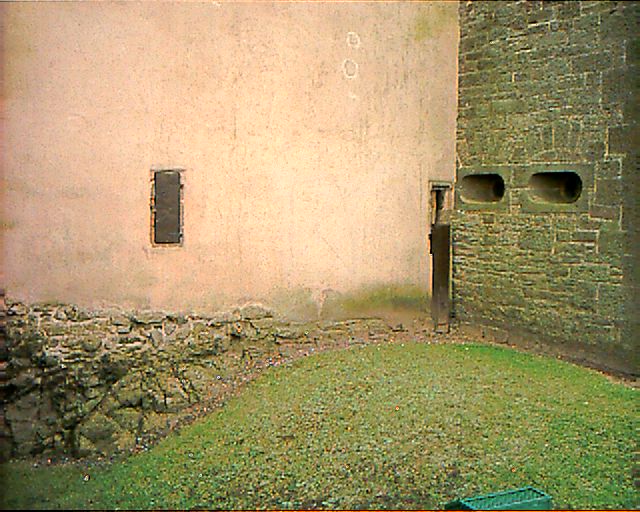
The tower is built directly on top of a rocky outrcrop
Looking up at the tower, you will notice that there are oval gun ports, through which defenders could fire at an approaching enemy. You can see these in the photograph above. The gun ports are lined up so that the defenders could fire across the faces of the walls. Further up the tower's walls are the rectangular windows of the main hall and the bedchambers above it, and near the top of the tower there is a parapet or walkway, from which defenders could fire down on an enemy below. There are also rainwater spouts, projecting out from the tops of the walls, designed to channel rainwater away from the walls. At the very top of the tower there are tall chimney stacks.
If you turn around, you will be facing the harbour, which has been very important in the castle's development (read more about the harbour below).
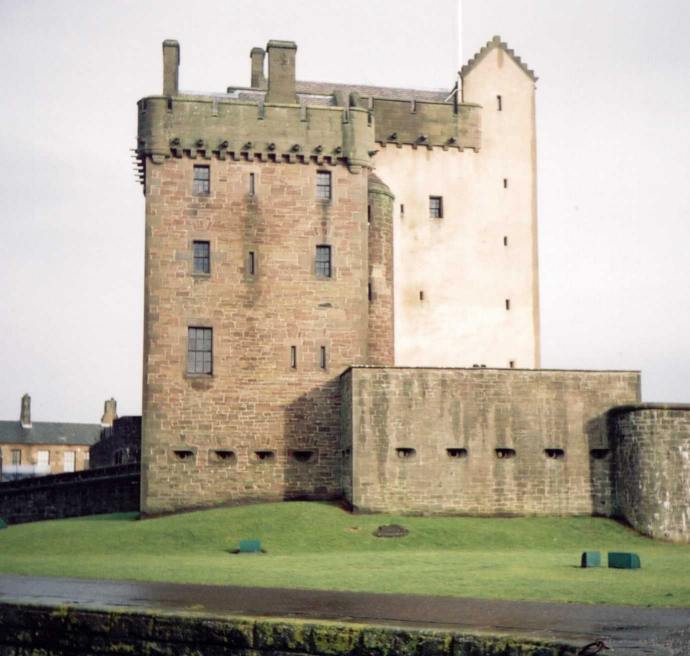
Looking up at the tower from near the entrance
The castle played an important role in the wars with England in the 1540s. There were several attacks on the castle, first by one side, then the other. A deep ditch was dug across the landward side of the promontory by an English garrison in 1547, and nowadays you cross this ditch as you walk up to the castle's entrance. In 1651, General Monck's army attacked the castle, and some damage was done to the walls of the tower by canon fire. If you look up at the tower you can still see some of this damage today.
Although it had figured prominently in earlier conflicts, by the late 18th century the castle was an abandoned ruin. In 1787, the poet Robert Burns described it as `a finely ruin jutting into the Tay'. There are several paintings showing the castle as a ruin, and you can see these in the museum inside the castle. In 1846, the castle was acquired by the Edinburgh and Northern Railway Company, which then built the adjacent harbour for a railway ferry (note: there was no rail bridge across the Tay at this time). There is a fine model of the Broughty Ferry railway quay in the castle museum.
In 1855, at the end of the Crimean War, the castle was bought by the War Office in order to defend the entrance to the River Tay from Russian ships. No major changes to the castle were made at that time, but in 1860, when it was feared there would be a war with France, it was decided to re-fortify the site. The re-fortifications of 1860-61 were carried out to the designs of the architect Robert Rowand Anderson. The work involved clearing away the remaining parts of the original courtyard. A new wing and a small courtyard were added onto the tower house and the courtyard walls were rebuilt. Emplacements were built for nine guns of various sizes.
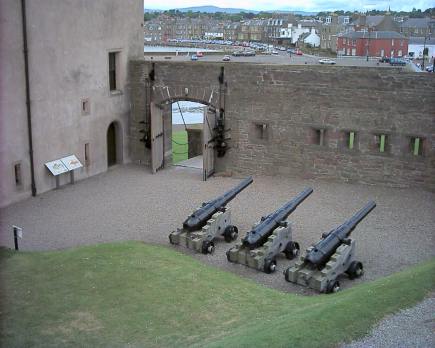
These three guns in the courtyard were made between 1859 and 1866
Just inside the castle's entrance, to the left, you will see three iron guns mounted on wooden gun carriages. These guns, known as `40 pounders', were among the guns used to defend the castle in the 1860s from the threat of French invasion. Later, these particular guns were buried in concrete and used as bollards beside the harbour. They were rediscovered some years ago, dug out of the concrete and restored.
The wall directly in front of these guns, with narrow, rectangular windows through it, was once part of a guardhouse, from which the castle's entrance could be guarded.
Further to the left, one of Anderson's 1860s gun emplacements can be seen (below, left), and, if you walk a short distance further along the courtyard wall, you will come to a caponier (below, right), added in 1860-61. A caponier is a gallery, projecting out from the courtyard walls, which allowed protective firing along the outer faces of the walls.
1860s gun position |
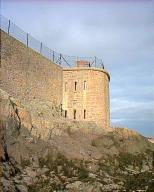 The caponier, seen from below |
Although most of the defensive structures added in the 1860-61 re-fortification were examples of straightforward military engineering works, Anderson's new west wing and courtyard, built onto the tower house, was constructed with some care, in an antique style, so that they matched the design of the original tower house (see below).
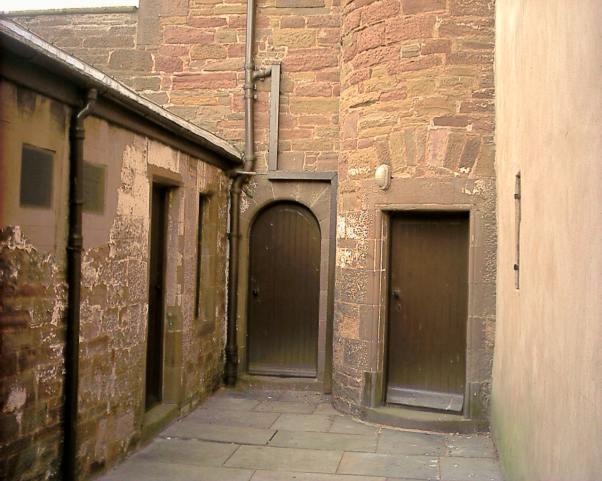
The west wing and its small courtyard
In the 1880s, the the castle's defences were criticised as being old-fashioned and inadequate. Experts declared that the castle could be destroyed by gunfire from a warship out at sea, beyond the range of the castle's guns. In 1886-7, a new range was built to the east of the castle to house the Tay Divison Submarine Miners, whose job it was to lay mines in the Tay if there were an emergency.
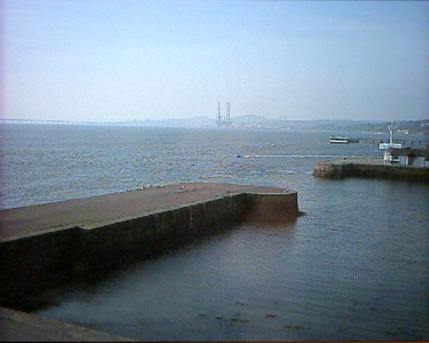
The mine-laying equipment was positioned at the end of this pier
In 1889-91 the gun empacements in the courtyard were re-modelled, and more powerful guns were installed. Two emplacements for 4.7" guns can still be seen in the courtyard. Underneath these is an ammunition store (called a magazine), and several smaller storage cupboards, which had steel doors, built into the concrete under the gun positions.
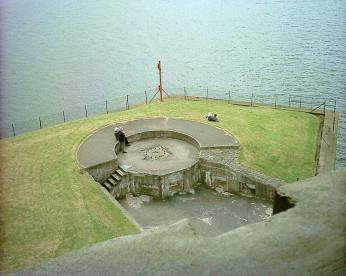 An 1890s gun emplacement (for a 4.7" gun) |
Storage cupboards underneath the gun emplacements |
Further gun positions were added in 1905 at Castle Green Battery, to the north-west of the castle (see The castle's relationships with its surroundings), and further alterations were made to the castle during both World Wars. A defence post was constructed at the top of the tower in 1942, during World War II.

This view of the tower from the south shows the World War II defence post (with windows and a flat roof) at the top of the tower.